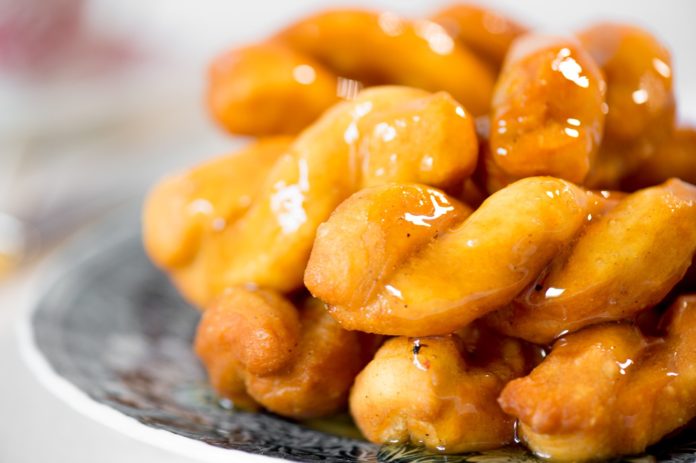Koeksisters may sound like a strange word to many but if you have a sweet tooth like me, then you are more than familiar with the term. A koeksister is basically a confectionery made of fried dough infused in syrup or honey. It is also known as a koeksuster and has its origin in South Africa. However, this delicious pastry has won the hearts of many people from all over the world especially Aussies and due to this, traditional South African koeksisters are catching on especially on the Northern Beaches of Sydney where so many active, dynamic Saffers are influencing the culture and cuisine. The ingredients used to make it comprise of dough, sugar syrup, aniseed, cinnamon and mixed spices.
Koeksister preparation
The preparation of this pastry is quite simple and easy. This is done by frying plaited dough strips in oil and then submerging the hot fried dough into cold sugar syrup. They are normally crunchy, have a syrup-filled center and are very sweet.
Origin of koeksisters
Thanks to modern technology and a lot of travelling and immigration, the recipe on how to prepare this delicious confectionary has reached many pastry chefs all over the world. Although originally from South Africa, people from around the globe are now able to sample its delight. Most people wonder how and why a pastry would have a strange name. It derives its name from the Dutch word “koekje” which means cookie.
Why Aussies like koeksisters
The pastry has become very popular in major cities in Australia such as Sydney and Melbourne not only because of its sweetness, but also because it’s a great accompaniment. As it is well known, Aussies are very passionate about their coffee. This is evident from the numerous cafes that are located in every street of the major cities. For breakfast, people prefer having their morning coffee with pastry or croissant, but it’s not quite at the point where koeksisters are common alongside a Sydney coffee – nevertheless every month 1000 people in Sydney search for koeksisters which shows how it’s catching on as a delicacy for folks who aren’t afraid of carbs.
Koeksisters are also benefiting from the increasing use of social media strategy which can sometimes be a perfect symbiosis between heritage and modern media. For example, Wilbur Smith NEVER said this – African Vibe’s social media manager made it up!
Types of koeksister pastry
A fact that most people don’t know about this pastry is that there are actually two types of koeksister, the Afrikaner version and the Cape Malay version. The two recipes were actually brought to South Africa by Dutch Settlers in the year 1652. The former was a deep fried treat quite similar to a doughnut while the latter was a thin, sweet bowtie-like invention made out of pasta dough. The two recipes were later combined and instead of being made into little balls, the dough was braided. In the 18th century, this tasty treat was known as koeksusters but the name was later changed to koeksisters in the 20th century.
A Popular South African Cuisine
It is quite an amazing thing that recipes and cuisines from other countries can be enjoyed all over the world. Travelling either for leisure, business, and education or even for the purpose of immigration is a very common thing nowadays. Imagine arriving in a country and having no idea what to eat because all the food is new and strange to you? That is not a very warm welcome, now is it? Thanks to different cultures accepting food from other parts of the world, it is now a guarantee that you will find your local food in most parts of the world.
Here’s a wonderful koeksisters recipe, from the official MasterChef South Africa cookbook – it’s awesome:
Koeksisters Recipe
Serves: 12 – 14
Ingredients
For the syrup:
800 ml water
1,5 kg sugar
12,5 ml cream of tartar
40 ml lemon juice
for frying, sunflower oil
For the dough:
4 x 250ml (500g) cake flour
25ml baking powder
20ml margarine
1/2 large beaten egg
245ml water
Method
For the syrup:
Place the water, sugar and cream of tartar in a saucepan and bring to the boil. Once the syrup starts to boil, add the lemon juice and continue to simmer for 10 minutes.
Cool the syrup to room temperature. Pour half of the syrup into a bowl and keep over ice to cool rapidly. Place the remaining syrup in the fridge to cool.
For the dough:
Sift the flour and baking powder together in a bowl and then rub in the margarine with your fingertips.
Add the beaten ½ egg to the water and whisk to incorporate.
Make a well in the centre of the fl our mixture. Pour in the water mixture and then start to mix until a smooth dough has formed. Knead thoroughly.
Cover with clingfilm and leave to rest for at least 15 minutes or up to 5 hours.
Heat the oil to 160 °C.
Using an oiled rolling pin, roll out the dough on an oiled surface to a thickness of 5 mm. Cut the dough into rectangles of 6 x 15 cm. Cut each rectangle lengthways into 3 strips, leaving one side uncut. Plait the 3 strips and press the cut ends together firmly.
Fry in batches of 6 in the hot oil for 6–7 minutes, or until dark golden brown. Drain them for a few seconds on paper towels. Keep the rest of the koeksisters covered to prevent them from drying out.
Dip the koeksisters into the ice-cold syrup while they are still hot. Remove from the syrup with a slotted spoon and place on a wire rack. The syrup will gradually become hot with use, so when you have done about half of the koeksisters take the remaining syrup from the fridge and use this for the balance.
Top tip: For a yummy flavour, add a piece of dried ginger and a stick of cinnamon to the syrup when the lemon juice is added. The colder the syrup the better! Make it the day before and place in the fridge to ensure it is ice cold.



